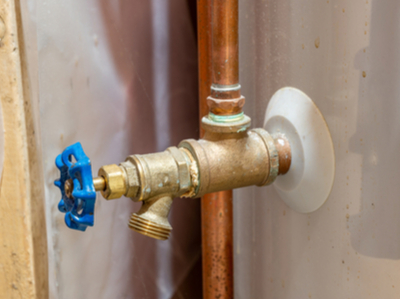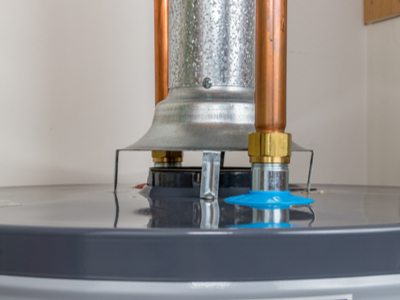This free webinar will be held Dec. 7 from 1:00 p.m. to 2:00 p.m. EST.
Did you miss our previous article…
https://www.ab-sessions-plumbing-building-services.com/?p=579
Mueller Associates Names Todd Garing President
Garing joined the firm in 1993 and has served as vice president and group manager since 2007.
Did you miss our previous article…
https://www.ab-sessions-plumbing-building-services.com/?p=578
How Air Conditioning Works

>
Before 1902, humans adopted creative ways of staying cool during hot summers. The ancient Egyptians hung wet reed mats in their windows that created a cooling effect when the wind blew through. Ancient Romans went so far as to pump cold water from aqueducts through the walls of elite homes.
These days you need only turn your thermostat dial for sweet heat relief in your home. But what exactly happens when you turn that magic dial? And how do you fix your AC when it doesn’t click on? Mike Diamond is the fresh smelling man with the answers to all things cool. We’ll cover the parts of a home ac system and explain how the air conditioning system in your house works. If your AC isn’t working, we’ll troubleshoot the common reasons why.
Who invented Air Conditioning (and the summer blockbuster)?
The man credited with inventing air conditioning as we know it is Willis Carrier. At the turn of the 20th century, he had an epiphany while standing on a train platform. He realized that humidity could be removed from air causing it to feel colder. Willis built a system of ice chilled coils that kept mills and printing companies cool during hot industrial workdays.

Stuart Cramer invented a ventilation device around the same time that was used in textile plants to distribute cool vapor to hot air. He was also the person to coin the term “air conditioning.” In 1925 he invented a more efficient version of his device for a movie theater. Soon his device was in theaters across the country. Ever since, Americans have flocked to the movies to escape the summer heat and thus was born the summer blockbuster season.
How Does Air Conditioning Work?
Modern air conditioning works via the physical principal of phase transition. This law states that when a liquid converts to a gas, it absorbs heat energy. Like when you boil water to create steam.
The liquid in this instance is a refrigerant or chemical compound that evaporates and condenses over and over to cool your home. The refrigerant starts as a liquid that travels through an evaporation coil inside your home. As the liquid evaporates it absorbs heat and, in this case, that heat is from warm air from your home. As the heat is removed, the resulting cool air is distributed back into your home.
The used refrigerant gas is then sent to your air conditioner compressor – that’s the big unit outside – where it is compressed back into a liquid. The hot air that is a byproduct of the process (remember phase transition) is vented outside and the condenser aids the compressor in sending the liquid refrigerant back to the evaporator coil where the cycle begins all over again.
How HVAC Systems Work
HVAC stands for heating, ventilation and air conditioning. Your home’s central air takes advantage of the existing ducts and vents in your home that are also used by your furnace during colder months.
After warm air travels over the evaporation coil and is cooled, fans blow the chilled air through your ducts and vents to reach every room of your home. This network delivers cold air evenly and efficiently throughout your home.
The thermostat connected to your HVAC system regulates all temperatures for both your heating and air conditioning. Each system responds based on the setting you input. Having one central control makes it easy to stay comfortable all year long.
Why Won’t My Air Conditioner Work?
Like any piece of equipment, air conditioners are subject to break down and failure. Common reasons air conditioners malfunction include:

No power.Blown fuse or tripped circuit.No signal from the thermostat.Too hot outside to keep up.Dirty or blocked air condenser.Dirty air filter.Broken fan.Problems with refrigerant.Unit not the right size for your home.Older unit (10+ years).Leaky air ducts.
Some of these issues are easier to address than others. If your air conditioner is not working, make sure its receiving power. Check that the circuit isn’t tripped and that your thermostat has fresh batteries. Then make sure your filter is clean and check your compressor for obstructions like brush or grass. If you’re still having problems, it may be time to have a professional technician look at it.
ir Conditioner Repair Service for Los Angeles
Mike Diamond knows air conditioning and HVAC systems. When things heat up, don’t lose your cool. Call or contact Mike Diamond for fast, reliable air conditioner service in Los Angeles and the surrounding area.
The post How Air Conditioning Works appeared first on Mike Diamond Services.
Did you miss our previous article…
https://www.ab-sessions-plumbing-building-services.com/?p=531
Bonney Acquires Boyd Plumbing Inc. expanding its Team of Plumbing Technicians
Second Acquisition for Bonney in the Skilled Trades Industry Sacramento, Calif. — Bonney Plumbing, Electrical, Heating and Air (Bonney), a home services company headquartered in Rancho Cordova, CA, announced it has acquired Sacramento-based Boyd Plumbing, Inc. Boyd has been a trusted provider of plumbing services to the Sacramento area and its neighboring communities since 2006. […]
The post Bonney Acquires Boyd Plumbing Inc. expanding its Team of Plumbing Technicians appeared first on Plumbing Perspective | News, Product Reviews, Videos, and Resources for today’s contractors..
Did you miss our previous article…
https://www.ab-sessions-plumbing-building-services.com/?p=445
Water Main Break + Hurricane Flooding at Massachusetts Maritime Academy
There’s never a good time for a water-main break. But when it happens in the aftermath of a major hurricane, well, that can certainly throw a wrench into things. In September, just after Hurricane Ida hit the United States, staff at Massachusetts Maritime Academy in Buzzards Bay were scrambling. They were preparing for students to […]
The post Water Main Break + Hurricane Flooding at Massachusetts Maritime Academy appeared first on Plumbing Perspective | News, Product Reviews, Videos, and Resources for today’s contractors..
Did you miss our previous article…
https://www.ab-sessions-plumbing-building-services.com/?p=444
Flex-Shaft Technology – The Next Big Thing
Drain cleaning professionals ignore new technology at their peril. As in most industries, if your competition has equipment that is better, faster, safer, and more professional, it puts you at a serious disadvantage. One need only look at the history of our industry in the past 30 years to see the truth in these statements. […]
The post Flex-Shaft Technology – The Next Big Thing appeared first on Plumbing Perspective | News, Product Reviews, Videos, and Resources for today’s contractors..
Tips To Market Your Plumbing Business
If you’re looking to grow your plumbing business you’ll need a way to stand out from the rest. With the help of these focus areas you’ll increase your visibility, both online and within your local community. Directory listings Local plumbing businesses must ensure that they are listed in the most popular online business directories. Adding […]
The post Tips To Market Your Plumbing Business appeared first on Plumbing Perspective | News, Product Reviews, Videos, and Resources for today’s contractors..
Niagara Wins EPA’s 2021 WaterSense Excellence Award
For Dedication in Helping Customers and Businesses Save Water Niagara®, the leader in high-performance, high-technology, water-saving toilets, accepted a 2021 WaterSense Excellence in Promoting WaterSense Labeled Products Award from the U.S. Environmental Protection Agency (EPA) for its dedication to helping customers and businesses save water, even with the challenges presented by the COVID-19 pandemic in […]
The post Niagara Wins EPA’s 2021 WaterSense Excellence Award appeared first on Plumbing Perspective | News, Product Reviews, Videos, and Resources for today’s contractors..
HIRI Predicts Overall Home Improvement Product Sales Growth to Continue into 2025
Data from the recently released market update provides insight to home and building marketing professionals as the industry continues to shift in the wake of COVID-19.
Did you miss our previous article…
https://www.ab-sessions-plumbing-building-services.com/?p=434
The Anatomy of Your Home’s Water Heater

>
Traditional water heaters look like large metal cylinders and are usually located in your basement or closet. While tankless water heaters are becoming more popular, this blog will focus on the workings of the more common traditional tank water heater.
Your water heater performs an important task that you probably don’t often think about. It supplies warm or hot water to all parts of your home for hand washing, showers, dishes and more. How is it that you have hot water at the turn of a knob? We’ll cover the water heater parts that make it happen and what to do if your hot water heater is not working the way it should.
Water Heater Anatomy
The two most common types of water heaters in US homes are the traditional electric and gas models. These two varieties have many of the same elements with the primary difference being their power sources. Their major components include:
Water tank. This stores the hot water until it’s needed at a faucet or appliance. Tanks come in different sizes depending on the amount of hot water needed. Most tanks are lined with a thin layer of glass. Transport your new water tank carefully to avoid cracking or breaking it.
Dip tube. This is the cold-water pipe that supplies new water to the water heater. As hot water exits the heater at the top, the dip tube replenishes the water supply at the bottom.
Hot water outlet. This is where hot water leaves the tank to travel through your home’s plumbing.

Thermostat. Like the thermostat for your home, your water heater’s thermostat regulates the temperature of the water. When the thermostat senses cold water at the bottom of the tank, it activates the burner or heating element to warm the water.
Drain valve. At the bottom of your water heater is a hose connection and valve. Use this to empty your tank once a year to prevent sediment build up inside the tank. Consult a professional if you’re unsure how to drain your water heater.
TPR valve. Water heaters have a temperature pressure relief valve near the top. This valve will open if the tank experiences excessive pressure or heat within. It prevents your water heater from exploding.
Internal anode rod. This rod attaches at the top of your tank. Like a magnet, it attracts the corrosive elements in your water so that they don’t eat away at the tank walls. Depending how corrosive your water is, you may need to replace your anode rod every few years.
Electric vs Gas Water Heater
The way in which your heater heats water depends on whether it is powered by electricity or natural gas. Below we explain the differences.
Electric water heaters

In addition to the parts above, electric water heaters also contain:
Heating element. This is a metal loop inside the tank. It’s powered by an electric resister and controlled by the thermostat. When electricity travels through it, it becomes hot and heats the water.
Electric water heaters have a thermostat mounted flush with the outside of an internal tank. This thermostat constantly senses the internal temperature of the tank. If it senses the temperature getting too low, it activates the heating element inside the tank. The tank’s internal heating element heats up the water stored in the tank. The heating works the same way an electric range heats up a pot of water. Once the water reaches the set temperature, the thermostat cuts off power to the heating element.
Gas water heaters
Additional parts that make up a gas water heater include:

Burner. The burner sits at the bottom of a gas heater. When the water inside the tank needs to be heated, a flame ignites from a pilot light. It’s essentially like heating a water kettle on a gas stove.
Vent Flue. This is a hollow “chimney” through the center of the tank. It vents the exhaust from the burner to the outside.
Thermocouple. This is a small rod beneath the burner. It senses if the pilot light is on and sends a signal to the burner to activate. If the pilot light goes out, the water heater thermocouple prevents the gas valve from opening and leaking gas into your home.
Gas water heaters have a thermostat just like electric ones do. The thermostats in gas water heaters contain a mercury sensor in the tip alongside a thermocouple. The thermocouple monitors the pilot light and the mercury sensor monitors the internal water temperature.
When the temperature inside the tank gets too low, the thermostat sends a signal to the gas control valve. This valve checks in with the thermocouple to make sure the pilot light is on. If it is, the valve opens and allows gas into a burner, igniting a flame. This flame heats the water. Once the water in the tank heats to the preferred temperature, the gas control valve closes again. The exhaust from the burner travels through the flue vent and safely outside.
How to choose the right water heater for your home?
Start by checking out our helpful guide! We’ll cover everything you need to consider when choosing a new water heater. That includes the right type, fuel, efficiency, and tank size to fit your needs.
How do I best maintain my water heater?
Make sure your drain the tank regularly to clear out any sediment build-up. If you don’t, sediment buildup in the tank will make the heater far less efficient.Set the water heater thermostat’s temperature to 120 degrees Fahrenheit or less. If you ever leave home for an extended period of time, consider turning the temperature down before you leave.Always keep an eye out for pooling water around the base of the heater’s tank. Catching small leaks before they become big ones will help save you a lot of money and trouble.
Los Angeles Water Heater Repair and Installation
If your water heater is leaking or you’re interested in upgrading your to a more energy efficient water heater, give the team at Mike Diamond a call. Our experts can help you choose the right make, model, and size for your home. Not only that, but we can install as quickly and efficiently as possible.
The post The Anatomy of Your Home’s Water Heater appeared first on Mike Diamond Services.
Did you miss our previous article…
https://www.ab-sessions-plumbing-building-services.com/?p=414
